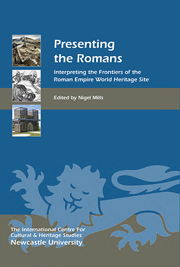Book contents
- Frontmatter
- Contents
- List of Illustrations
- Acknowledgments
- List of Abbreviations
- Preface
- Introduction: Presenting the Romans – Issues and Approaches to Interpretation
- 1 Tradition and Innovation: Creating a New Handbook to the Roman Wall
- 2 Re-enactment and Living History – Issues about Authenticity
- 3 Reconstruction Drawings: Illustrating the Evidence
- 4 Images from the Past: Fibulae as Evidence for the Architectural Appearance of Roman Fort Gates
- 5 Multimedia Interpretation Techniques for Reconstructing the Roman Past at the Limes Museum in Aalen and at the Limes in Baden-Württemberg
- 6 Vindonissa: Changing Presentations of a Roman Legionary Fortress
- 7 Bringing to Life the Ancient City of Viminacium on the Danube
- 8 An International View of Reconstruction
- 9 A Roman Museum for Vienna
- 10 Woerden – Hoochwoert (Dutch Limes): Showing the Invisible
- 11 Mainlimes Mobil: Presenting Archaeology and Museums with the Help of Smartphones
- 12 Voices from the Past: Presenting (re)Constructed Environments through Multimedia Technologies
- 13 Digital Reconstruction and the Public Interpretation of Frontiers
- 14 Information, Disinformation and Downright Lies: Portraying the Romans
- 15 Romanes eunt Domus?
- 16 The Living Frontier: the Passing of Time on Hadrian's Wall
- 17 The Hadrian's Wall Interpretation Framework: Audience Research
- 18 The Hadrian's Wall Interpretation Framework
- 19 Applying the Hadrian's Wall Interpretation Framework
- List of Contributors
- Index
- Heritage Matters
10 - Woerden – Hoochwoert (Dutch Limes): Showing the Invisible
Published online by Cambridge University Press: 05 September 2013
- Frontmatter
- Contents
- List of Illustrations
- Acknowledgments
- List of Abbreviations
- Preface
- Introduction: Presenting the Romans – Issues and Approaches to Interpretation
- 1 Tradition and Innovation: Creating a New Handbook to the Roman Wall
- 2 Re-enactment and Living History – Issues about Authenticity
- 3 Reconstruction Drawings: Illustrating the Evidence
- 4 Images from the Past: Fibulae as Evidence for the Architectural Appearance of Roman Fort Gates
- 5 Multimedia Interpretation Techniques for Reconstructing the Roman Past at the Limes Museum in Aalen and at the Limes in Baden-Württemberg
- 6 Vindonissa: Changing Presentations of a Roman Legionary Fortress
- 7 Bringing to Life the Ancient City of Viminacium on the Danube
- 8 An International View of Reconstruction
- 9 A Roman Museum for Vienna
- 10 Woerden – Hoochwoert (Dutch Limes): Showing the Invisible
- 11 Mainlimes Mobil: Presenting Archaeology and Museums with the Help of Smartphones
- 12 Voices from the Past: Presenting (re)Constructed Environments through Multimedia Technologies
- 13 Digital Reconstruction and the Public Interpretation of Frontiers
- 14 Information, Disinformation and Downright Lies: Portraying the Romans
- 15 Romanes eunt Domus?
- 16 The Living Frontier: the Passing of Time on Hadrian's Wall
- 17 The Hadrian's Wall Interpretation Framework: Audience Research
- 18 The Hadrian's Wall Interpretation Framework
- 19 Applying the Hadrian's Wall Interpretation Framework
- List of Contributors
- Index
- Heritage Matters
Summary
Introduction
In the Dutch city of Woerden, civil servants, local authorities, developers, enthusiastic citizens and archaeologists have succeeded, by working together, in revealing to the general public the city's invisible Roman past. There are several reasons for this success. The aim of bringing the Roman past to life through visual display was an integral aspect of an archaeological heritage management programme, and served a range of purposes (social, historical, educational and commercial). The framework that was built for presenting the city's Roman history concerned not only the hardware (pictures, displays etc) but also the people who use it, such as guides and teachers. All of this amounts to a considerable advance in bringing the invisible Roman past to life and in highlighting the importance and value of archaeology to the city. This chapter looks back on the path taken to realising the vision of Roman Woerden, paying special attention to the process and to key decisions made along the way.
The Woerden – Hoochwoert Project: Development, Research and Storytelling
Work has been ongoing since the 1990s to develop a new shopping complex around a yet-to-be-constructed square by the Church of St Peter (Petruskerk) in the centre of the typical Dutch fortified city of Woerden. The development included an underground car park designed to hold 560 cars.
- Type
- Chapter
- Information
- Presenting the RomansInterpreting the Frontiers of the Roman Empire World Heritage Site, pp. 93 - 102Publisher: Boydell & BrewerPrint publication year: 2013

